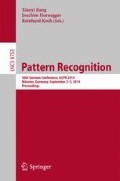Abstract
Most computer vision and especially segmentation tasks require to extract features that represent local appearance of patches. Relevant features can be further processed by learning algorithms to infer posterior probabilities that pixels belong to an object of interest. Deep Convolutional Neural Networks (CNN) define a particularly successful class of learning algorithms for semantic segmentation, although they proved to be very slow to train even when employing special purpose hardware. We propose, for the first time, a general purpose segmentation algorithm to extract the most informative and interpretable features as convolution kernels while simultaneously building a multivariate decision tree. The algorithm trains several orders of magnitude faster than regular CNNs and achieves state of the art results in processing quality on benchmark datasets.
Access this chapter
Tax calculation will be finalised at checkout
Purchases are for personal use only
References
Matlab image processing toolbox. http://www.mathworks.com/help/images/
Becker, C., Ali, K., Knott, G., Fua, P.: Learning context cues for synapse segmentation in EM volumes. In: Ayache, N., Delingette, H., Golland, P., Mori, K. (eds.) MICCAI 2012, Part I. LNCS, vol. 7510, pp. 585–592. Springer, Heidelberg (2012)
Borenstein, E., Ullman, S.: Class-specific, top-down segmentation. In: Heyden, A., Sparr, G., Nielsen, M., Johansen, P. (eds.) ECCV 2002, Part II. LNCS, vol. 2351, pp. 109–122. Springer, Heidelberg (2002)
Boykov, Y., Kolmogorov, V.: An experimental comparison of min-cut/max-flow algorithms for energy minimization in vision. IEEE Trans. Pattern Anal. Mach. Intell. 26(9), 1124–1137 (2004)
Breiman, L., Friedman, J.H., Olshen, R.A., Stone, C.J.: Classification and Regression Trees. Wadsworth & Brooks, Monterey (1984)
Cardona, A., Saalfeld, S., Preibisch, S., Schmid, B., Cheng, A., Pulokas, J., Tomancak, P., Hartenstein, V.: An integrated micro-and macroarchitectural analysis of the drosophila brain by computer-assisted serial section electron microscopy. PLoS Biol. 8(10), e1000502 (2010)
Ciresan, D., Giusti, A., Schmidhuber, J., et al.: Deep neural networks segment neuronal membranes in electron microscopy images. Adv. Neural Inf. Process. Syst. 25, 2852–2860 (2012)
Gall, J., Yao, A., Razavi, N., Van Gool, L., Lempitsky, V.: Hough forests for object detection, tracking, and action recognition. IEEE Trans. Pattern Anal. Mach. Intell. 33(11), 2188–2202 (2011)
Graves, A., Schmidhuber, J.: Offline handwriting recognition with multidimensional recurrent neural networks. In: Advances in Neural Information Processing Systems, pp. 545–552 (2008)
Heath, D., Kasif, S., Salzberg, S.: Induction of oblique decision trees (1993)
Kreutz-Delgado, K., Murray, J.F., Rao, B.D., Engan, K., Lee, T.W., Sejnowski, T.J.: Dictionary learning algorithms for sparse representation. Neural Comput. 15(2), 349–396 (2003)
Laptev, D., Vezhnevets, A., Dwivedi, S., Buhmann, J.M.: Anisotropic ssTEM Image segmentation using dense correspondence across sections. In: Ayache, N., Delingette, H., Golland, P., Mori, K. (eds.) MICCAI 2012, Part I. LNCS, vol. 7510, pp. 323–330. Springer, Heidelberg (2012)
Lawrence, S., Giles, C.L., Tsoi, A.C., Back, A.D.: Face recognition: a convolutional neural-network approach. IEEE Trans. Neural Netw. 8(1), 98–113 (1997)
Levinshtein, A., Sminchisescu, C., Dickinson, S.: Optimal image and video closure by superpixel grouping. Int. J. Comput. Vis. 100(1), 99–119 (2012)
Lowe, D.G.: Object recognition from local scale-invariant features. In: The Proceedings of the Seventh IEEE International Conference on Computer Vision, vol. 2, pp. 1150–1157. IEEE (1999)
Mairal, J., Bach, F., Ponce, J., Sapiro, G., Zisserman, A.: Supervised dictionary learning (2008). arXiv preprint arXiv:0809.3083
Montillo, A., Tu, J., Shotton, J., Winn, J., Iglesias, J., Metaxas, D., Criminisi, A.: Entanglement and differentiable information gain maximization. In: Criminisi, A., Shotton, J. (eds.) Decision Forests for Computer Vision and Medical Image Analysis, pp. 273–293. Springer, Heidelberg (2013)
Nocedal, J.: Updating quasi-newton matrices with limited storage. Math. Comput. 35(151), 773–782 (1980)
Sandberg, K., Brega, M.: Segmentation of thin structures in electron micrographs using orientation fields. J. Struct. Biol. 157(2), 403–415 (2007)
Sklansky, J., Michelotti, L.: Locally trained piecewise linear classifiers. IEEE Trans. Pattern Anal. Mach. Intell. 2, 101–111 (1980)
Vincent, P., Larochelle, H., Bengio, Y., Manzagol, P.A.: Extracting and composing robust features with denoising autoencoders. In: Proceedings of the 25th International Conference on Machine Learning, pp. 1096–1103. ACM (2008)
Yang, J., Jiang, Y.G., Hauptmann, A.G., Ngo, C.W.: Evaluating bag-of-visual-words representations in scene classification. In: Proceedings of the International Workshop on Multimedia Information Retrieval, pp. 197–206. ACM (2007)
Zhu, L., Chen, Y., Yuille, A.: Learning a hierarchical deformable template for rapid deformable object parsing. IEEE Trans. Pattern Anal. Mach. Intell. 32(6), 1029–1043 (2010)
Zhu, Q., Yeh, M.C., Cheng, K.T., Avidan, S.: Fast human detection using a cascade of histograms of oriented gradients. In: 2006 IEEE Computer Society Conference on Computer Vision and Pattern Recognition, vol. 2, pp. 1491–1498. IEEE (2006)
Author information
Authors and Affiliations
Corresponding author
Editor information
Editors and Affiliations
Rights and permissions
Copyright information
© 2014 Springer International Publishing Switzerland
About this paper
Cite this paper
Laptev, D., Buhmann, J.M. (2014). Convolutional Decision Trees for Feature Learning and Segmentation. In: Jiang, X., Hornegger, J., Koch, R. (eds) Pattern Recognition. GCPR 2014. Lecture Notes in Computer Science(), vol 8753. Springer, Cham. https://doi.org/10.1007/978-3-319-11752-2_8
Download citation
DOI: https://doi.org/10.1007/978-3-319-11752-2_8
Published:
Publisher Name: Springer, Cham
Print ISBN: 978-3-319-11751-5
Online ISBN: 978-3-319-11752-2
eBook Packages: Computer ScienceComputer Science (R0)

